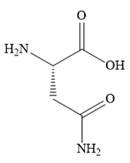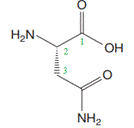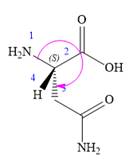
Concept explainers
Interpretation:
The IUPAC name of
Concept introduction:
The IUPAC name of a compound is made up of three parts: prefix, root, and suffix. If the compound contains different
If any chiral carbons are present, their absolute configurations are determined on the basis of Cahn-Ingold-Prelog rules and listed at the start along with the carbon number.
Answer to Problem F.1P
The IUPAC name of
Explanation of Solution
The structure of

The highest priority function group in
There are two other functional groups,
The root carbons are numbered from the carboxylic acid carbon as shown below.

This puts the amino group on C2 and the carbamoyl on C3. The carbon to which the amine group is attached is a chiral carbon. Based on the Cahn-Ingold-Prelog rules, the absolute configuration at this carbon is S.

Apparently, the three highest priority groups are arranged clockwise, but with the lowest priority hydrogen pointing toward the observer. Therefore, the actual configuration is S.
Therefore, the complete IUPAC name of
The highest priority functional group is considered as suffix, and the other remaining groups are considered as substituents for writing IUPAC name of the molecule.
Want to see more full solutions like this?
Chapter F Solutions
EBK GET READY FOR ORGANIC CHEMISTRY
- Draw the major product karmed when I reach with the epoxide. Use walge dah bonds, including hydrogen al alcach genic center, to show the chemistry of the product Beeldraw any hydrogen akams on coxygen where applicablearrow_forwardCurved arrows are used to illustrate the flow of electrons. Using the provided starting and product structures, draw the curved electron-pushing arrows for the following reaction or mechanistic step(s). Be sure to account for all bond-breaking and bond-making steps. H I Select to Add Arrows + H H 'H Q H2O H2O CI:O .H H H H I Select to Add Arrows I : C H2O H H H Select to Add Arrows 'Harrow_forward+ Draw an alkyl halide that produces ONLY the following alkene in an E2 elimination. Ignore any inorganic byproducts. Drawing Strong Base Q Atoms, Bonds and Rings Charges HO Br H2N Undo Reset Remove Done Drag To Panarrow_forward
- For the dehydrohalogenation (E2) reaction shown, draw the major organic product. Хок Br tert-butanol heat Select Drew Templates More Erase CH QQQarrow_forwardMacmillan Learning Draw the major, neutral organic product for each substitution reaction. For this question, assume that each substitution reaction goes to completion. Disregard elimination. Reaction A. CI H₂O Select Draw Templates More Erase C Harrow_forwardMacmillan Learning Reaction B: CI HO_ 곳으 / Select Draw Templates More с € H D Erasearrow_forward
- When 2-bromo-93-dimethylbutane is heated with sodium methoxide, one majors.. në la formed. 4th attempt Part 1 (0.5 point) t Ji See Periodic Table See Hint Draw the major alkene product and all other byproducts. Be sure to include lone-pair electrons and charges. Part 2 (0.5 point) What type of mechanism is occuring? Choose one: AS1 3rd attempt X H 41 See Hint Part 1 (0.5 point) Feedback See Periodic Table See Hintarrow_forwardComplete the mechanism for the E1 reaction below by following the directions written above each of the five boxes. Be sure to include lone pair electrons and nonzero formal charges. 2nd attempt 1 Provide the missing curved arrow notation. E+ RUDDA 1st attempt Feedback See Periodic Table See Hint Iir See Periodic Table See Hintarrow_forwardHeating an alcohol in the presence of sulfuric or phosphoric acid will cause a dehydration to occur: the removal of the elements of water from a molecule, forming an alkene. The reaction usually follows an E1 mechanism. The SN1 pathway is suppressed by using a strong acid whose conjugate base is a poor nucleophile. Further, heating the reaction mixture causes a greater increase in the rate of E1 compared to the rate of Sy1. 3rd attempt h Draw curved arrow(s) to show how the alcohol reacts with phosphoric acid. TH © 1 0 0 +1% # 2nd attempt Feedback H Ju See Periodic Table See Hint H Jud See Periodic Table See Hintarrow_forward
- Part 2 (0.5 point) 0- Draw the major organic product with the correct geometry. 10 1: 70000 х く 1st attempt Part 1 (0.5 point) Feedback Please draw all four bonds at chiral centers. P See Periodic Table See Hintarrow_forwardHeating an alcohol in the presence of sulfuric or phosphoric acid will cause a dehydration to occur: the removal of the elements of water from a molecule, forming an alkene. The reaction usually follows an E1 mechanism. The SN1 pathway is suppressed by using a strong acid whose conjugate base is a poor nucleophile. Further, heating the reaction mixture causes a greater increase in the rate of E1 compared to the rate of S№1. 2nd attempt 0 See Periodic Table See Hint Draw the organic intermediate from the first step (no byproducts) and draw curved arrow(s) to show how it reacts. TH +11: 1st attempt Feedback H H H C F F See Periodic Table See Hintarrow_forwardThis molecule undergoes an E1 mechanism when stirred in methanol. 3rd attempt CH₂OH CH₂OH 6148 O See Periodic Table. See Hint Draw 3 chemical species including formal charges and lone pairs of electrons. Add the missing curved arrow notation. H N O O SA 3 Br Iarrow_forward
 Organic ChemistryChemistryISBN:9781305580350Author:William H. Brown, Brent L. Iverson, Eric Anslyn, Christopher S. FootePublisher:Cengage Learning
Organic ChemistryChemistryISBN:9781305580350Author:William H. Brown, Brent L. Iverson, Eric Anslyn, Christopher S. FootePublisher:Cengage Learning Chemistry for Today: General, Organic, and Bioche...ChemistryISBN:9781305960060Author:Spencer L. Seager, Michael R. Slabaugh, Maren S. HansenPublisher:Cengage Learning
Chemistry for Today: General, Organic, and Bioche...ChemistryISBN:9781305960060Author:Spencer L. Seager, Michael R. Slabaugh, Maren S. HansenPublisher:Cengage Learning



